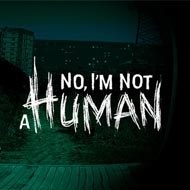

No, I’m not a Human places you in a grim future where nothing is certain, and everyone is suspect. The apocalypse has shattered the world, leaving isolated survivors clinging to hope behind locked doors. But the real danger isn’t outside — it’s the moment you open up and let someone in. Are they just another lost soul… or something far more dangerous pretending to be?
This game drops you into a fixed first-person perspective, placing you inside a guarded home where you make life-and-death calls from behind a single door. Every day, strangers arrive, asking to be let in. Their faces look human. Their voices sound right. But something is always off. It’s your job to spot the fakes — the inhuman Visitors mimicking people — before they cross the threshold.
No, I’m not a Human revolves around these critical gameplay systems:
The gameplay is simple on the surface, but deeply psychological. Every visitor could be a clue or a killer. One hesitation may save a life — or destroy your own.
No, I’m not a Human doesn’t bombard you with chaos — instead, it lets the fear grow slowly. You never know what the next knock will bring. And as each day passes, the Visitors grow smarter, more subtle, and harder to detect. Some imitate emotions. Some copy clothing. Others repeat phrases they’ve heard from actual humans. The game forces you to decide based on fragments of truth.
Core tension systems include:
There are no guarantees. Even seemingly helpful tools — like a working radio or stored drink — come with hidden risks. Survival depends on how well you read people, not how fast you react. This is a horror game where your greatest weapon is doubt.
More than just its mechanics, No, I’m not a Human excels at creating an immersive, dread-soaked atmosphere. The world outside your home remains hidden, but its presence is felt through distant sirens, crackling news reports, and the shifting behavior of those who knock. There’s no soundtrack guiding your emotion — just silence, tension, and the hum of impending danger.
Notable features that deepen immersion:
This approach fosters deep paranoia. The more you play, the more you start to second-guess what you once thought were clear signs. What seemed like certainty becomes hesitation. And in this game, hesitation kills.
No, I’m not a Human doesn’t bombard you with exposition. Instead, it lets you piece together the truth from fragments: what visitors say, how they say it, and what they don’t say at all. One might tell you about their sick child. Another may claim to be a former officer. Are they real? Are they testing you? Or are they just repeating things they’ve heard from others?
Some players will try to be kind. Others will reject everyone. There is no “correct” approach — only the one you can live with. This is a game that thrives on uncertainty and rewards attention to detail. If you’re too trusting, you’ll fall. If you’re too cold, you may regret the lives you abandon.
No, I’m not a Human is built on tension, ambiguity, and constant challenge. Every visitor is a riddle. Every choice echoes into what happens next. If you think you’re good at spotting liars… think again. This game is ready to prove otherwise.